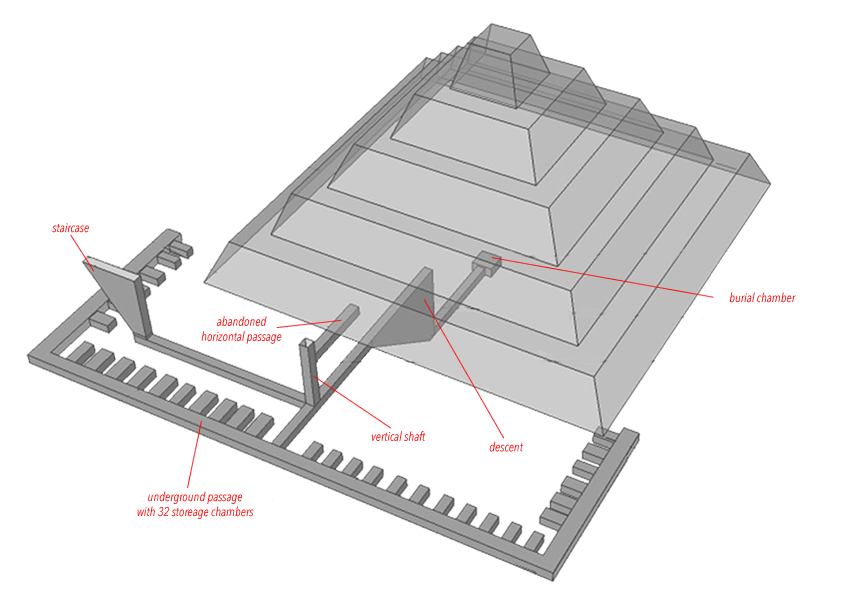|
 The Layer Pyramid (known locally in Arabic as il-haram il-midawwar,
meaning rubble-hill pyramid) is located 8 km south-west of Giza, close
to the necropolis of Zawyet el-Aryan. It is thought to be the tomb of
pharaoh Khaba of the III Dynasty, but this is disputed. The Layer Pyramid (known locally in Arabic as il-haram il-midawwar,
meaning rubble-hill pyramid) is located 8 km south-west of Giza, close
to the necropolis of Zawyet el-Aryan. It is thought to be the tomb of
pharaoh Khaba of the III Dynasty, but this is disputed.
The Layer pyramid was first excavated and examined in 1839 by John Shae
Perring. The subterranean passages were found and excavated in 1896 by
Jacques de Morgan. Further and more detailed investigation were
performed in 1900 by Alessandro Barsanti and in 1910 - 1911 by
George Reisner and Clarence Fisher. They also investigated the pyramid
surroundings. Unfortunately, the pyramid and its surroundings lie within
an a military restricted area since 1970 and there has been no
excavation ever since.
The Layer pyramid has a square base measuring 84 x 84 m, its layers and
outer walls have an inward inclination angle of 68°. If finished the
pyramid would have comprised five steps and reached c. 45 m in height.
Today only two steps remain and reach about 17 m in height. The current
ruined state of the pyramid allows a view of its core: its foundations
are made of the natural bedrock and measure 11 x 11 m. These are
surrounded by layers made of mud bricks. Each layer is 2,6 m thick. It
is disputed, if the pyramid was finished, or left unfinished.
Egyptologists such as Rainer Stadelmann believe that the pyramid was
finished, but others, such as
Miroslav Verner, think that the building
was left unfinished because of the pharaoh's sudden death.

The
entrance lies on the eastern site. A pretty steep stairway leads down to
a corridor which heads toward west. The corridor ends in a straight
vertical shaft, which splits up into a T-shaped crossway. To the left it
leads to the king's chamber, to the right it leads to a U-shaped gallery
system. The ground plan of the gallery system reminds to the shape of a
comb, it consists of 32 chambers and was possibly used as storage room
for the grave goods. The king's chamber was nearly quadratic and
contained no traces of a sarcophagus.
Interestingly, the necropolis of the Layer pyramid shows no traces of an
enclosure wall. At its eastern site, the pyramid shows traces of a
mortuary temple, but the archaeological traces are so scarce, that any
closer examination and more precise reconstruction is impossible today.
The same goes for the ruins of a building several hundred metres away
from the pyramid, it might have been the valley temple. An eastern
position of the building would be unusual, though. Around 200 m from the
pyramid, a huge mastaba can be found, it's today known as Mastaba Z500.
Inside this mastaba several stone bowls with the horus name of king
Khaba were found.
The architecture of the Layer pyramid allows a secure datation in the
time span between the rulership of king Sekhemkhet and king Snofru, the
founder of the IV
Dynasty. Stadelmann, Verner and
Jean-Philippe Lauer
compare the architecture of the Layer Pyramid with that of the step
pyramids of Djoser and
Sekhemkhet, expecting the Layer Pyramid to have
once consisted of 5 steps, just as its contemporary predecessors. The
building shows at one site developments concerning complex
substructures and simplifications concerning the building methods on the
other side. The Layer pyramid is a clearly advanced version of the
buried pyramid of Sekhemkhet.
The only problem about the Layer pyramid is the question of who builded
it. Most of today scholars believe that it was Khaba, since his name
appears on bowls found in Mastaba Z500. Rainer Stadelmann goes further
and identifies Khaba with king Huni, the last ruler of the
III Dynasty.
His evaluation is based on the
Turin
Canon. King Huni is credited with
a rulership of 24 years. According to Stadelmann, this time span would
perfectly cover the time span needed to complete the building of the
Layer pyramid. He also argues, that royal monuments of the first three
Egyptian dynasties only present a king's horus name, later document only
the throne- or birth name. Thus, he connects the cartouche name Huni
with Khaba. The Layer pyramid would therefore be Huni's tomb, too. |

![]()
![]()

